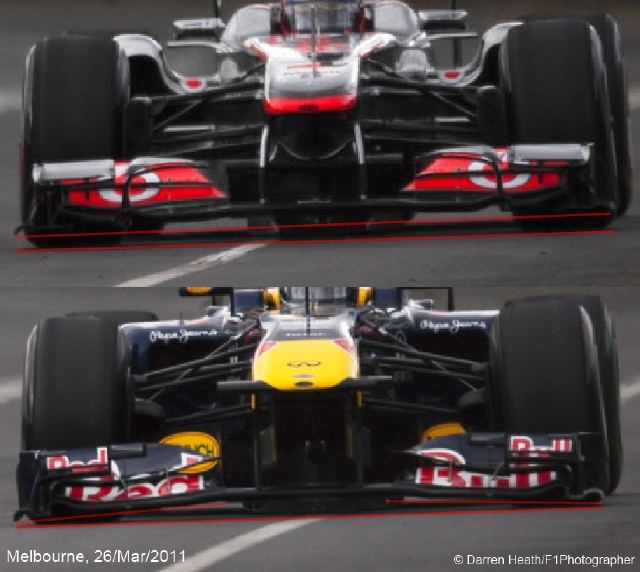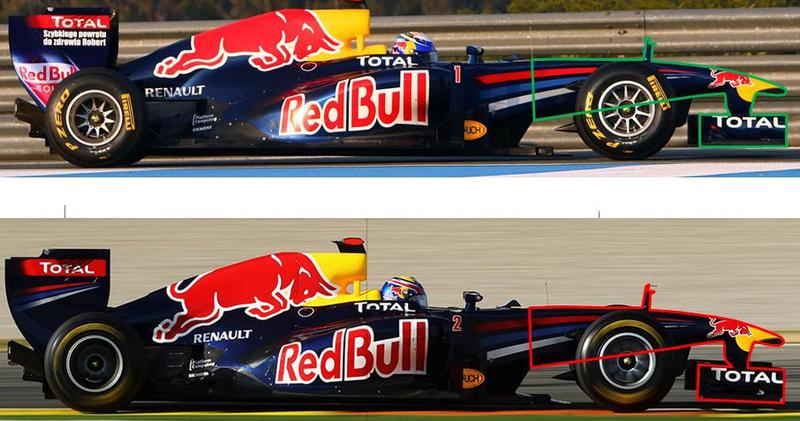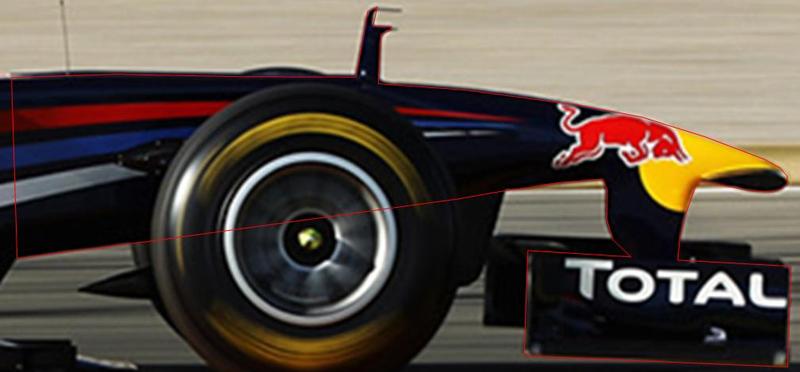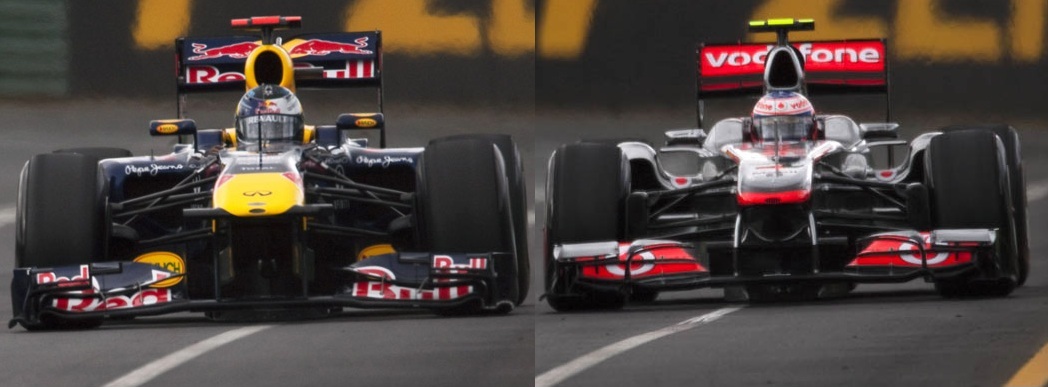Technical Red Bull's Front Wing (Revisited)
- Thread starter snowy
- Start date
Putting aside the rights and wrongs, though, it is an engineering marvel. To get the right amount of flex on the wing when the downforce is increasing exponentially with the air speed, so that it achieves the required position without touching the ground even under braking, and then for it to pass all the tests thus far used by the FIA, even the enhanced ones. It must have a considerable effect on the airflow to the rest of the car as well.
No wonder the others are scratching their heads.
No wonder the others are scratching their heads.
sobriety
Race Winner
Putting aside the rights and wrongs, though, it is an engineering marvel. To get the right amount of flex on the wing when the downforce is increasing exponentially with the air speed, so that it achieves the required position without touching the ground even under braking, and then for it to pass all the tests thus far used by the FIA, even the enhanced ones. It must have a considerable effect on the airflow to the rest of the car as well.
I wonder how much of their agreed budget it took as well, although it's a zero effective cost once you get it right!
I totally agree with you on this one G, that's why I can't find myself on the side of the illegal argument. As I said before, I think this system is so clever I prefer to think of it in the same bracket as the sliding skirt. Technically illegal but a brilliant invention.
http://www.f1sa.com/index.php?optio...t-wing-flex-not-illegal&catid=1:f1&Itemid=157 Charlie Whiting has dismissed fears Red Bull could fall afoul of the Formula One rules prohibiting flexible aerodynamic components.
As was the case in 2010, the dominant team has again been accused of running a car whose front wing extremities bend to the track, so much in Australia that mechanics were constantly repairing damage to the endplate undersides.
But FIA technical delegate Whiting told Germany's Bild newspaper: "We have found nothing unusual. The car is in order."
The real issue for Red Bull's rivals is the overall lap time gap witnessed particularly in qualifying, although it is suggested Sebastian Vettel sandbagged en route to Melbourne victory.
"Between us and Red Bull is a big gap," admitted McLaren's Lewis Hamilton, who finished second at Albert Park.
Added Mercedes' Norbert Haug: "The last time we saw a car so superior was a long time ago."
He told Sport Bild: "Even without our problems, we would only have admired Red Bull from afar."
How thoroughly disappointing.
This - "so much in Australia that mechanics were constantly repairing damage to the endplate undersides" - says it all.
I will forever consider Red Bull's titles to be tainted due to this, in the same way that some consider Hamilton's title to be tainted, or some of Ferrari's titles to be tainted.
This - "so much in Australia that mechanics were constantly repairing damage to the endplate undersides" - says it all.
I will forever consider Red Bull's titles to be tainted due to this, in the same way that some consider Hamilton's title to be tainted, or some of Ferrari's titles to be tainted.
Some interesting images on here (apologies if it's been posted before). Whatever Whiting, the scrutineers or anyone from RBR might say about the matter, there is clearly something odd going on to allow such an apparently flexible element to continually pass the rigidity tests:
http://spontoncristiano.wordpress.com/?s=
I was particularly interested in the fact that the whole wing seems to tip forwards as well as down at the outer extremities. Could this be the key? It's presumably related in some way to the fact that the initial load on the wing under race conditions is horizontal (i.e. the airflow over the wing caused by the car's horizontal movement) and is then converted to a downward force by the shape of the wing itself. I've always thought that an ideal test would in some way replicate these forces, rather than simply applying a vertical load to one point on the wing.
http://spontoncristiano.wordpress.com/?s=
I was particularly interested in the fact that the whole wing seems to tip forwards as well as down at the outer extremities. Could this be the key? It's presumably related in some way to the fact that the initial load on the wing under race conditions is horizontal (i.e. the airflow over the wing caused by the car's horizontal movement) and is then converted to a downward force by the shape of the wing itself. I've always thought that an ideal test would in some way replicate these forces, rather than simply applying a vertical load to one point on the wing.
Interesting pictures Chad. I've not seen those before.
I completely agree that it's an amazing design but what I find mystifying is that we can blatantly see from this that the Red Bull wing is flexing (who the hell needs a load test!) yet Sauber find themselves disqualified over a technical infringement that is unlikely to have a performance advantage.
Unlike this...
http://spontoncristiano.files.wordpress.com/2011/03/contouroverlaye.jpg
Unlike this...
http://spontoncristiano.files.wordpress.com/2011/03/contouroverlaye.jpg
J
johnnoble1990
Guest
Hamilton might do well to wonder why bits of his car are trailing on the ground, no?
Maybe this is Mclaren's way of countering the flexible front wing; the flexible undertray.
Not sure if this has been posted on CTA yet, but a very good introduction to what it is that Red Bull have produced. As with most people I am annoyed that Whiting seems to arbitrarily decide which regulations to enforce, and admiration that Newey and Co. have got this system to work so well...
http://mccabism.blogspot.com/2011/02/fokker-d8-and-f1-front-wings.html
http://mccabism.blogspot.com/2011/02/fokker-d8-and-f1-front-wings.html
Seems as though others admire Newey as well.Great pictures and what a brilliant design from Newey and the Red Bull engineering team. We want innovation, here it is.
http://motorsportpress.wordpress.co...-segrave-trophy-at-the-royal-automobile-club/
At a special award lunch today (Wednesday 30 March) held at the Royal Automobile Club, London, Formula 1 designer Adrian Newey became winner of the Segrave Trophy for 2010. Newey was awarded the trophy for being the only Formula 1 designer to have designed championship-winning cars for three different teams – Williams F1, McLaren and, in 2010, Red Bull Racing.
The Segrave Trophy is awarded to a British subject with ‘the Spirit of Adventure’ for the most outstanding demonstration of transportation by land, air or water; the award was created in 1930 to commemorate the life of Sir Henry Segrave. This year’s Segrave celebration was the first of a number of events being held throughout 2011 to mark the 100th anniversary of the Royal Automobile’s Club House in Pall Mall.
Sir Henry Segrave was the first British driver to win a Grand Prix in a British car, at the French Grand Prix at Tours in 1923, the first to hold both the land and water speed records simultaneously and the first person to travel at over 200mph (320km/h) in a land vehicle. On June 13, 1930 he broke the water speed record on Windermere in the Lake District. On the return run his boat capsised after hitting a log. He was rescued and taken unconscious to hospital. He briefly regained consciousness and asked ‘Have I broken the record?’ He was told of his achievement before dying moments later.
snowy
Champion Elect
Thanks snowy 
I'll try harder next time

I'll try harder next time
snowy
Champion Elect
Sorry Chad, hope I haven't offended you. It is just that I am paranoid about clicking on links and lazy, so I didn't see those images for ages! When I did take the time to look at them I was quite impressed by how graphically they show what RBR are doing. Then I thought perhaps there are more paranoid and lazier people than me around. 

Similar threads
- Replies
- 12
- Views
- 2K
- Article
- Replies
- 75
- Views
- 5K
- Replies
- 61
- Views
- 7K
- Article
- Replies
- 112
- Views
- 9K





